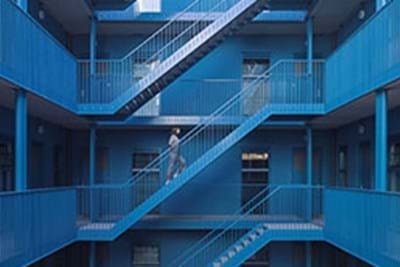- Home EN
- News
- Latest news
- 2020
- Eindhoven Strijp S resi complex pioneers smart living with successful ‘Live the Future’ lab
Eindhoven Strijp S resi complex pioneers smart living with successful ‘Live the Future’ lab
Real estate asset managers such as Bouwinvest undoubtedly have a responsibility to make the built environment 'Paris Proof', or compliant with the Global Climate Change Accord, but our mission cannot succeed without intensive cooperation with our partners in the property chain. During an 18-month period, Bouwinvest conducted a pilot project at the BLOK 61 residential complex at Strijp S in Eindhoven, together with VolkerWessels iCity, to connect several apartments to a direct current (DC) grid powered by sustainably generated energy. The ‘Live the Future’ living lab is a first step towards smart and sustainable homes for the long term incorporating high-tech solutions that reduce CO2 emissions, make more efficient use of raw materials and increase living comfort.
The advantage of DC grids over conventional alternating current (AC) systems is that they are more energy-efficient and the living lab we have created in Eindhoven with VolkerWessels iCity marks the first steps towards a new standard in Smart DC homes. The project is unique partly because this was the first time in the Netherlands that more than one home was connected to a DC grid. As a growing number of towns and cities around the country become self-sufficient in generating their own power supplies, whether that be by district heating, solar or wind energy, more and more opportunities will arise for the installation of DC grids. As part of our efforts to stimulate innovation in the field of smart living, we have bundled our insights, conclusions and recommendations in a white paper entitled ‘Smart DC Lofts and opportunities for smarter living.’

Since the summer of 2017, a selected group of tenants have been living in 14 sustainable, high-tech apartments at the top of the BLOK 61 residential complex, equipped with sensors to monitor movement and living conditions. Smart products and services continue to be developed and tested, and all these innovations create new opportunities for the Internet Of Things in homes – the application of smart technology in more and more devices. Using a customised app, residents in BLOK 61, for example, are able to regulate and control room temperature, energy flows and alarm systems themselves. The active involvement of residents was an important part of the project.
The idea for the SMART DC Lofts evolved from the need for more innovative thinking about sustainable energy and social responsibility to protect our environment. The DC grid installed in the BLOK 61 apartments in Eindhoven involved a process of trial and error, but a major goal was achieved as the DC standard for residential has now been defined which marks a major move forward to further innovation in this market. But this breakthrough is only a first step: much more is possible. As tech giant Apple has pointed out, much still needs to be done to develop software protocols and a new range of household appliances, such as dishwashers and washing machines, that are ready for DC grids. The added value of DC will then increase further.
The living lab has led to a positive result In several areas, in terms of overcoming technical challenges and building a community with residents and all our technical partners. The objectives outlined in the area of privacy and security have also been achieved. The data regulation is secure and functions optimally, guaranteeing the safe exchange of residents' data. The residents also proved to be very cooperative, as long as there was clear communication about the goal from the various parties and guarantees about secure data exchange.